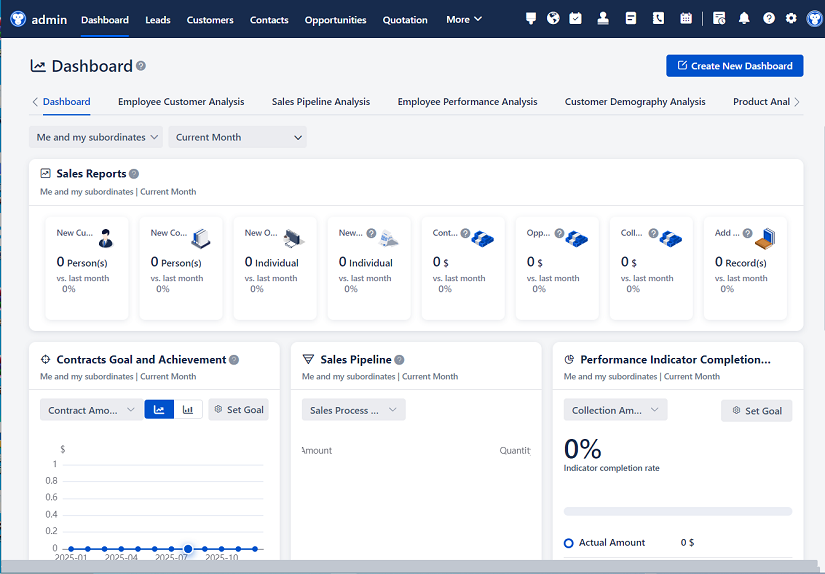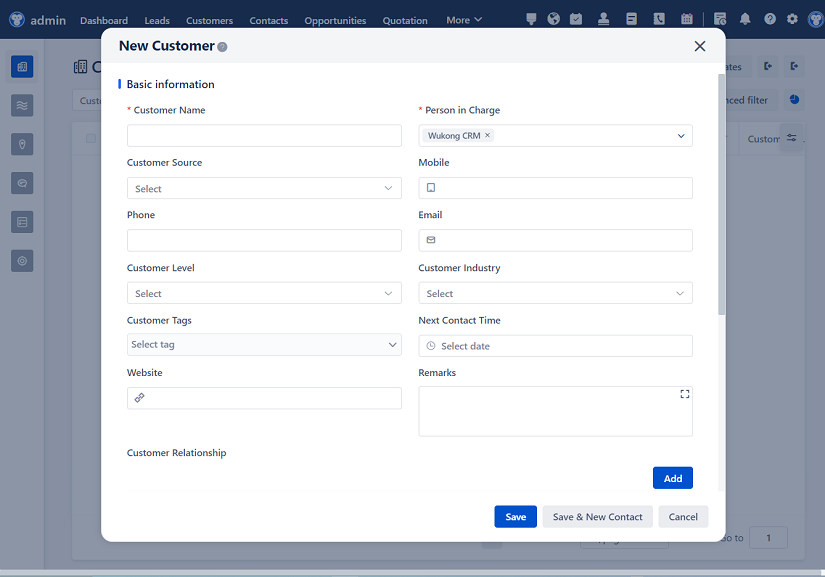
△Click on the top right corner to try Wukong CRM for free
You know, when I first started learning about CRM systems and data warehouses, I honestly thought they were just two separate tools that lived in different corners of a company’s tech stack. But the more I dug into it, the more I realized how powerful they become when you actually connect them. Like, imagine having all your customer interactions—emails, calls, purchases, support tickets—nicely stored in your CRM, while your data warehouse holds years’ worth of sales trends, marketing campaign results, and behavioral patterns. Alone, each system is useful. But together? That’s where magic happens.
So here’s the thing: integrating CRM systems with data warehouses isn’t just some fancy IT project for big corporations. It’s becoming essential for businesses of all sizes that want to really understand their customers. Think about it—your sales team logs every conversation in Salesforce or HubSpot, right? But if that data never makes it into your analytics platform, how can you spot trends over time? How do you know which leads convert best? Or why certain customers churn?
Free use of CRM system: Free CRM
I remember talking to a small e-commerce business owner who told me, “We had great CRM data, but we couldn’t answer simple questions like ‘Which customers bought after our last email campaign?’” That hit me. They were collecting data, sure, but not using it. Once they connected their CRM to their cloud data warehouse (they used Snowflake), suddenly they could pull reports showing exactly which campaigns drove repeat purchases. And guess what? Their marketing ROI improved almost overnight.
Now, let’s break this down a bit. A CRM—Customer Relationship Management system—is basically your frontline tool for managing customer interactions. It tracks everything from lead generation to post-sale support. On the other hand, a data warehouse is like a giant library of historical data. It pulls information from multiple sources—ERP systems, websites, CRMs—and organizes it so you can run deep analyses. The problem? These two usually don’t talk to each other unless you make them.

And that’s where integration comes in. You’re essentially building a bridge between real-time operational data (CRM) and long-term strategic insights (data warehouse). It’s not always easy, though. I’ve seen companies try to do this manually—exporting CSV files, importing them, hoping nothing breaks. Spoiler: it breaks. A lot. One finance manager told me, “We spent 20 hours a week just moving data around. It was ridiculous.” Automating that flow with integration tools like Fivetran, Stitch, or even custom APIs makes life so much easier.
But hey, it’s not just about saving time. When CRM and data warehouse are synced, you get a 360-degree view of the customer. Let me give you an example. Say a customer service rep sees a ticket come in. With integrated systems, they can instantly see not only past support history but also purchase behavior, lifetime value, and even sentiment analysis from previous emails. That kind of context changes how you treat that customer. You’re not just solving a problem—you’re strengthening a relationship.
And from a leadership perspective? This integration is a game-changer for decision-making. Executives aren’t guessing anymore. They can ask, “How does customer satisfaction correlate with renewal rates?” and get an actual answer backed by data. One VP of Sales at a SaaS company said, “Before integration, forecasts were educated guesses. Now, they’re based on real pipeline data combined with historical close rates. Our accuracy jumped from 60% to over 85%.”
Of course, it’s not all smooth sailing. Data quality is a huge issue. If your CRM has duplicate entries, missing fields, or outdated info, that garbage flows straight into your warehouse. And as we all know, garbage in, garbage out. So before you even think about integration, you’ve got to clean up your CRM data. I can’t stress this enough. Take the time to standardize naming conventions, remove duplicates, and enforce data entry rules. Trust me, your future self will thank you.
Another challenge? Security and compliance. Customer data is sensitive. When you’re moving it between systems, especially across clouds, you’ve got to make sure you’re following GDPR, CCPA, or whatever regulations apply to your region. Encryption, access controls, audit logs—these aren’t optional. One company I worked with delayed their integration by three months just to get their security policies approved. Was it frustrating? Sure. But better safe than sorry.
Now, let’s talk about the actual process. How do you integrate these systems? Well, there are a few ways. You can use ETL (Extract, Transform, Load) tools that pull data from your CRM, clean it up, and push it into the warehouse. Tools like Talend or Informatica are solid for this. Or, if you’re using modern cloud platforms, you might go with ELT (Extract, Load, Transform), where raw data lands in the warehouse first, and transformation happens there. Snowflake and BigQuery handle this really well.
Some CRMs even offer native connectors. Salesforce, for instance, has integrations with several data warehouses through middleware like MuleSoft or directly via APIs. HubSpot users can sync data to Redshift or Google BigQuery using third-party tools. The key is choosing a method that fits your tech stack and skill level. You don’t need a PhD in data engineering to make this work—there are user-friendly platforms now that guide you step by step.

Once the data is flowing, the real fun begins: analytics and reporting. You can build dashboards that show customer acquisition costs by channel, track churn risk using predictive models, or segment customers based on behavior. Marketing teams love this stuff. One marketer told me, “We used to target everyone the same way. Now, we personalize emails based on purchase history and engagement. Open rates went up by 40%.”
And it’s not just marketing. Sales teams use integrated data to prioritize high-value leads. Support teams identify recurring issues and proactively reach out. Even product teams benefit—they can see which features are most used by top customers and focus development there.
Let’s not forget AI and machine learning. With rich, unified data, you can train models to predict customer lifetime value, recommend next-best actions, or detect fraud. One fintech startup used CRM-warehouse integration to build a model that flags at-risk accounts before they cancel. They reduced churn by 15% in six months. That’s huge.
But here’s something people often overlook: integration isn’t a one-time project. It’s ongoing. CRMs evolve, data models change, new sources emerge. You need monitoring tools to ensure data pipelines stay healthy. Alerts for failed syncs, data drift detection, regular audits—these keep everything running smoothly.
Culture matters too. Just because the tech works doesn’t mean people will use it. Training is crucial. I’ve seen brilliant systems underused because employees didn’t know how to interpret the reports. So invest in change management. Show teams how this helps them do their jobs better. Make it relevant.
And finally, start small. Don’t try to integrate every field from every object on day one. Pick a high-impact use case—say, syncing contact and deal data to analyze sales performance. Prove the value, then expand. One company started with just three tables and grew to over 50 synced objects within a year. They built confidence gradually.
Look, I get it—this sounds complex. But the truth is, the gap between CRM and data warehouse is one of the biggest missed opportunities in business today. Companies collect tons of data but fail to connect the dots. By bridging that gap, you turn scattered information into actionable intelligence.
So if you’re sitting there thinking, “Maybe someday we’ll get around to this,” I’d say: don’t wait. The tools are more accessible than ever. Cloud platforms have made integration faster and cheaper. And the payoff? Better customer experiences, smarter decisions, and stronger growth.
At the end of the day, it’s not about technology—it’s about people. Happy customers, empowered teams, confident leaders. And that starts with knowing your data, not just collecting it.
FAQs (Frequently Asked Questions):
Q: What’s the main benefit of integrating CRM with a data warehouse?
A: The biggest benefit is getting a complete, accurate, and historical view of your customers. Instead of working with siloed data, you can combine real-time interactions from your CRM with deep analytical insights from your warehouse to make smarter business decisions.
Q: Do I need a data engineer to set this up?
A: Not necessarily. While complex setups may require technical expertise, many modern tools (like Fivetran, Stitch, or Zapier) are designed for non-technical users. You can often set up basic integrations with minimal coding.
Q: How often should data be synced between CRM and the warehouse?
A: It depends on your needs. For most businesses, daily syncs are sufficient. But if you need real-time analytics (like live dashboards), you might opt for hourly or even near-real-time updates.
Q: Can small businesses benefit from this integration?
Absolutely. In fact, smaller companies often see faster ROI because they’re more agile. Even with limited data, connecting CRM and warehouse helps uncover insights that drive growth.
Q: What are common pitfalls to avoid?
Watch out for poor data quality, lack of clear goals, ignoring security, and trying to do too much too soon. Start with a focused use case, clean your data, and scale gradually.
Q: Which CRM and data warehouse combinations work best together?
Salesforce + Snowflake, HubSpot + BigQuery, and Microsoft Dynamics + Azure Synapse are popular and well-supported pairings. But most modern systems can integrate with the right middleware or API setup.
Q: Is cloud integration safer than on-premise?
Cloud solutions often have stronger built-in security features (like encryption and automatic updates), but safety ultimately depends on how you configure and manage access. Always follow best practices for authentication and permissions.

Q: How do I measure the success of the integration?
Track metrics like report accuracy, time saved on manual data tasks, improvement in forecast accuracy, customer retention rates, and overall ROI from data-driven campaigns.
Related links:
Free trial of CRM
Understand CRM software

△Click on the top right corner to try Wukong CRM for free